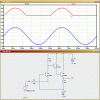I am proceeding with my project, and have found the remaining question for me is this:
I have a 20Hz 5Vpp sinewave. The circuit generating it is a PIC with op amp buffer. It runs on a 6V battery supply with the normal ground at 0V.
I would like to feed this into a darlington emitter follower that has +12 and +6 rails. In other words, I want the output DC level to be shifted upward 6V from the input. As well as the expected increase in current.
This is the circuit I have breadboarded, but nothing I know to try has worked. Can someone please tell me what needs to be changed to achieve the above result?
I have a 20Hz 5Vpp sinewave. The circuit generating it is a PIC with op amp buffer. It runs on a 6V battery supply with the normal ground at 0V.
I would like to feed this into a darlington emitter follower that has +12 and +6 rails. In other words, I want the output DC level to be shifted upward 6V from the input. As well as the expected increase in current.
This is the circuit I have breadboarded, but nothing I know to try has worked. Can someone please tell me what needs to be changed to achieve the above result?










